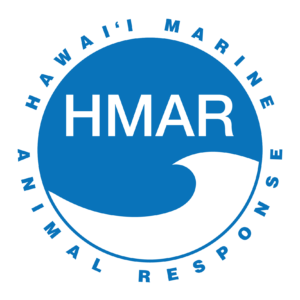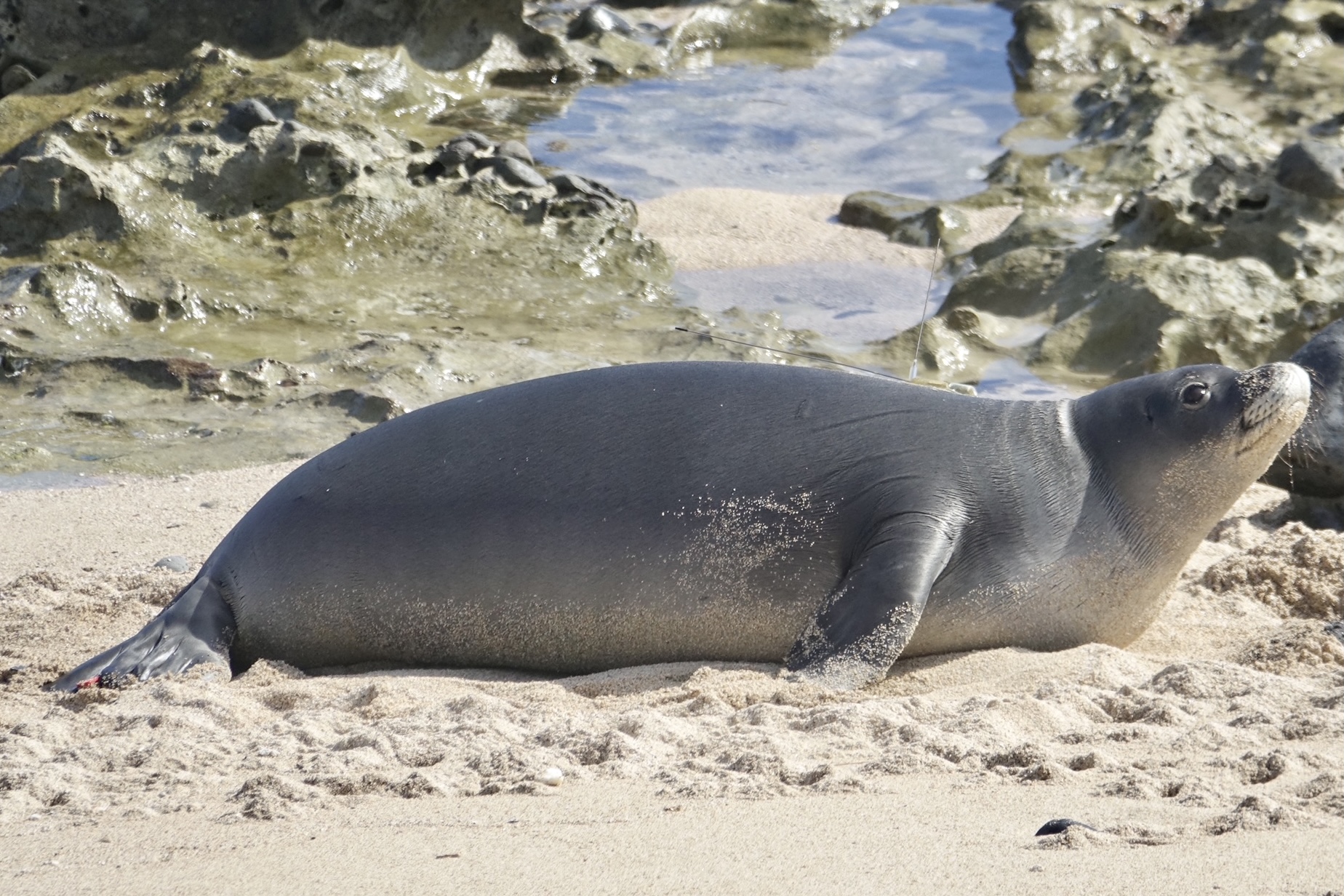August 2023 Update
MONTHLY HMAR UPDATE: August 2023
August had big sea turtle rescues, marine debris retrievals, and awards! We’re so excited to tell you all about it!
Number of contacts made to HMAR hotlines in August 2023 – 1,209 contacts
This is broken out as 950 calls regarding Hawaiian monk seals, 153 calls regarding sea turtles, 30 calls regarding seabirds, and 76 were calls not regarding marine animals of concern.
Number of field support actions conducted in August 2023 – 326 actions
This was broken out as 25 actions in the east section of Oʻahu, 89 in the lower west area, 4 in the upper west area, 14 in the north section of Oʻahu, and 194 actions in the southeast area.
 In July, RK96 ("Kaʻiwi") was hanging out in Waikīkī, and last month, it was RH58 ("Rocky")! Rocky has been in Waikīkī for the past week or so (see picture left), and joining her are RK24 “Wāwāmalu” and RN14! It has been jam-packed with lots of back and forth between the males and switching beaches.
In July, RK96 ("Kaʻiwi") was hanging out in Waikīkī, and last month, it was RH58 ("Rocky")! Rocky has been in Waikīkī for the past week or so (see picture left), and joining her are RK24 “Wāwāmalu” and RN14! It has been jam-packed with lots of back and forth between the males and switching beaches.
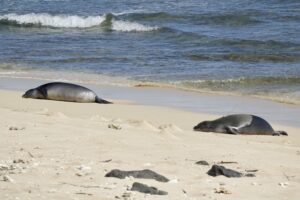
In addition, the rest of Oʻahu’s pups now have names! PO3/RS34 is now named “Moana,” and PO4/RS12 is “Hoku,” meaning “deep sea” and “star,” respectively. We are so grateful to Mālama Honua Elementary School in Waimānalo for gifting RS34 and RS12 their names! PO6/RS08 was named “Maluhia,” meaning “peaceful or serenity,” and PO7/RS20 was gifted the name “Lāhina,” meaning “sunray or sunbeam.” Waialua Elementary School gifted RS08 and RS20 their names (see picture right)! Mahalo to our school partners for all their hard work and dedication in gifting these names to our seals! If you want to learn more about the meaning of these names, see our social media post!
Number of rescues, interventions, stranding responses, and escalated field actions in August 2023 – 21
This was broken out as 16 sea turtle rescues, 5 seabird rescues, and 0 Hawaiian monk seal escalated field actions.
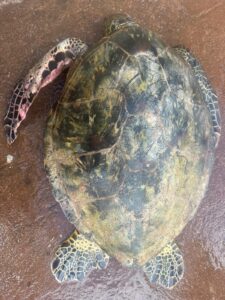 We had two big turtle rescues this month!
We had two big turtle rescues this month! 
On August 7th, we got a call of a turtle stuck at the intake of the HECO power plant near Electric Beach (see picture left). The workers there pulled the turtle out and noticed it had fishing line wrapped around its left front flipper. Unfortunately, the workers cut the entanglement off of the turtle before calling the hotline. We responded to the turtle, assessed it, and determined it should be brought to NOAA for veterinarian support. Upon further inspection, the turtle’s flipper was necrotic and needed to be amputated. Thankfully, the flipper was amputated without complications and the turtle was released on the west side of Oʻahu last week (see picture right)! This instance is a fantastic reminder of why you should never cut an entanglement off of an animal. If this turtle had been returned to the ocean after the line was removed, that necrotic flipper would have caused many health issues, and the turtle would likely have died. If you find an animal with an entanglement or other injury, you should always call the statewide Marine Animal Hotline at (888) 256-9840 to report it and not attempt to intervene.
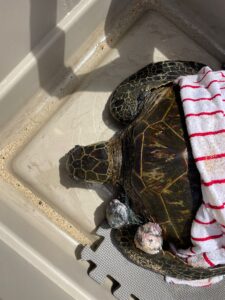
Later in the month, we received a call about a turtle swimming at Laniakea with line wrapped around its left front flipper. We were lucky that at the same time, we were getting the call about this turtle, we got a message from one of our rescue volunteers who was reporting a seal a few beaches down the road! Thankfully, our volunteer could go to the beach and locate the turtle for us. She noted that the turtle had line wrapped around the left front flipper and its neck and right front flipper. The turtle was actively swimming and foraging. However, given the extent of the entanglement, we needed to respond. Our responders arrived and found our rescue volunteer, who stayed on site and watched over the turtle for us until we arrived. We were able to walk over to the turtle and collect it with a net. In addition to being wrapped around the front half of the turtle, the line extended into the mouth as well. Using a speculum, we opened the turtleʻs mouth to look inside and noted several tumors inside the mouth, so much so that our responders couldn't see into the turtleʻs throat. Given these conditions, we felt it best to for veterinarians to make another assessment. We hope to have updates on this turtle for you all in the coming months.
Marine debris - awesome work
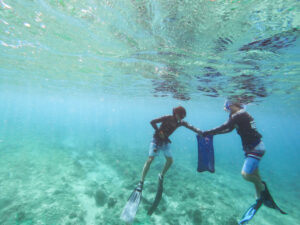
At the beginning of August, two staff members attended the Hawai’i Marine Debris Action Plan (HIMDAP) Workshop. They met with partners and discussed essential action items to prevent and remove marine debris around the islands. It was a very productive day, and we’re excited to continue participating with the HIMDAP community.
This month during 6 dives we collected, 3,691 feet of line and 817 animal hazards! In addition to our dives, we also had six large debris removals from beaches around the island in our role as the Hawaiʻi DLNR Marine Debris Rapid Response contractor on Oʻahu. Altogether, this debris weighed around 700 pounds and primarily consisted of nets!
Number of people reached through face-to-face outreach and education in August 2023 - 2,092
This month, volunteers in our Education & Engagement program had a pretty easy month. We participated in our regular Waikīkī Aquarium outreach events and had the opportunity to educate hundreds of visitors and residents on Hawaiʻi's marine protected animals, marine debris, and our ocean ecosystem.
Additional news & updates
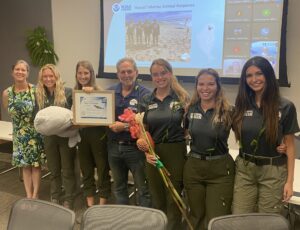
HMAR was awarded the Partner in the Spotlight Award by NOAA Fisheries last month. The Partner in the Spotlight Award is given to one organization annually that works with a species designated as a “Species in the Spotlight” by NOAA. Species in the Spotlight designates that a particular species needs additional attention from the public to ensure its continuation. We are beyond proud of our work with the Hawaiian monk seal population on Oʻahu and Molokai, and we extend a huge mahalo to our partners at NOAA for their help and support over the years.
When we learned we were getting the Partner in the Spotlight award, we knew we also had to recognize our volunteers because we simply could not do what we do without all of them. So we threw them a party! At the end of the month, 20 of our volunteers, our staff, and some of the NOAA team gathered at our facility to celebrate our award and our volunteer accomplishments! We had a great time celebrating with our volunteers!
Mahalo for your support!
______________________________________________________________________________
WHAT DO THESE NUMBERS MEAN?
Number of Calls - What does this mean? These are calls our hotline operators answer about any species in any situation. Whether it is a monk seal on the beach, a sea turtle of concern in the water, or a seabird that needs help. HMAR answers the calls that are made to the NOAA’s marine wildlife number for Oʻahu and Molokai and we take calls from the public, from the police, fire department, Ocean Safety as well as State of Hawaii agencies. Any call that comes into our hotline is reported here. Some calls result in a field response but many are valuable for animal sightings information or other data that can assist in research. Since our start in 2016, we’ve handled over 62,000 hotline contacts.
Number of Field Support Actions - What does this mean? This is when HMAR sends volunteer or staff resources into the field to perform a variety of actions in support of marine protected animals including Hawaiian monk seals, sea turtles, sea birds, dolphins, and whales. Since our start in 2016, we have had volunteers or staff in the field over 27,000 times.
Number of Rescues, Interventions, Stranding Responses and Escalated Field Actions - What does this mean? This number includes any field response that goes above and beyond a typical resting monk seal response. This includes responding to a seal of concern, an entangled, hooked, or injured sea turtle, a seabird in need of medical support, and other situations. Since 2016, we have performed nearly 2,260 of these operations.
Marine Debris Work - Each week our marine debris team removes underwater entanglement hazards (net, line, hooks) from high fishing pressure areas to reduce animal entanglements, hookings, injuries and death of protected marine animals. Since we started our underwater removal activities, our Marine Debris Program (MDP) has removed more than 5,000 animal hazards, cleaned over 275 acres of underwater habitat, and we have collected many MILES of monofilament fishing line. Taking all of this debris out of underwater habitat helps save Hawaiian monk seals, sea turtles, and seabirds.
Number of People Reached through Face to Face Outreach - What does this mean? HMAR’s different program activities put our volunteers and staff in direct contact with Hawaii’s residents and visitors. Educating people about Hawaii’s marine protected species and our ocean ecosystem is one of our highest priorities and has an important impact on reducing threats. This number includes outreach done on the beaches as well as the work our Education and Engagement team does going to classes and community outreach events. Since our start we’ve reached 315,000 people.
Thank you for your continued support!
July 2023 Update
MONTHLY HMAR UPDATE: July 2023
Lots of seals in Waikīkī this month and one exciting turtle rescue! Overall, July was a relatively calm month by our standards. Read on to learn more!
Number of Contacts Made to HMAR Hotlines in July 2023 – 1,133 contacts
This included 917 contacts for Hawaiian monk seals, 122 contacts for sea turtles, 23 contacts for seabirds, and 71 contacts for other reasons.
Number of Field Support Actions Conducted in July 2023 – 212 actions
This included 19 field actions in the east section of Oʻahu, 39 in the lower west section, 2 in the upper west section, 17 in the north section, and 135 in the southeast section.
It has been a busy seal month for us! We say a lot of the time that our responses come in waves, seal calls are typically pretty consistent  but our sea turtle and seabird rescues seem to all happen around one time and then slow down significantly. But every once in a while, we get a massive influx of seals all over the island - July was one of those times! We had a particularly busy few weeks on the beaches in Waikīkī. RK96 “Kaʻiwi” (see picture left) went through her annual molt right in the middle of town for everyone to watch! She is now finished and looking shiny and bright and new!
but our sea turtle and seabird rescues seem to all happen around one time and then slow down significantly. But every once in a while, we get a massive influx of seals all over the island - July was one of those times! We had a particularly busy few weeks on the beaches in Waikīkī. RK96 “Kaʻiwi” (see picture left) went through her annual molt right in the middle of town for everyone to watch! She is now finished and looking shiny and bright and new!
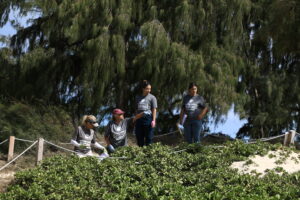 This month we also completed our first round of wedgetail shearwater colony surveys on the island (see picture right). Both colonies have stayed consistent since last year, with our Kahuku colony numbering over 500 birds! We will survey both colonies again in October to see how many chicks we have before they fledge and go off to sea.
This month we also completed our first round of wedgetail shearwater colony surveys on the island (see picture right). Both colonies have stayed consistent since last year, with our Kahuku colony numbering over 500 birds! We will survey both colonies again in October to see how many chicks we have before they fledge and go off to sea.
Number of Rescues, Interventions, Stranding Responses, and Escalated Field Actions in July 2023 – 18
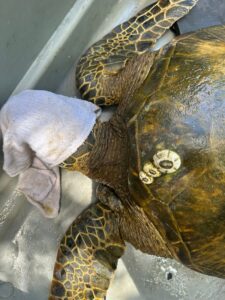 This included 7 sea turtle responses 10 seabird responses, and 1 Hawaiian monk seal escalated field action.
This included 7 sea turtle responses 10 seabird responses, and 1 Hawaiian monk seal escalated field action.
On Tuesday, July 25th, our team received a call concerning a green sea turtle entangled at Puaʻena Point (see picture left). Upon our arrival, it was evident that the turtle was entangled around both its front flippers and neck. Thanks to our early intervention, we were able to disentangle the sea turtle and conducted a comprehensive evaluation before preparing it for release. The proactive involvement of members of the public, who promptly reported the situation, enables us to intervene early and achieve success in our rescue missions. We extend our heartfelt appreciation to these individuals whose support is crucial in safeguarding our marine protected species.
Remember, if you see a marine protected animal of concern, please do not attempt to intervene. This can be dangerous for you, can result in further problems for the animal, does not allow us to conduct a proper assessment and examination of the animal, and likely constitutes a violation of federal and state laws. What is most important is that you call the statewide marine animal hotline at (888) 256-9840 as quickly as possible, provide photos, and detailed GPS or location information. Your quick and detailed contact will allow us to determine the best action to take and allows us to dispatch trained and permitted responders as needed.
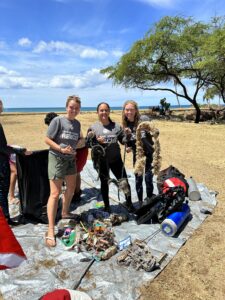
Marine Debris - Awesome Work
This month we had two partner cleanups! Our first was with Aaronʻs Dive Shop at Pokai Bay. As a group, we removed 110 pounds of trash all within a few hours! It was great to meet new divers and clean up a space known for protected species! We also did a beach cleanup with Luluʻs at Ala Moana Beach Park!
HMAR collected 1,306 feet of monofilament this month, 355 animal hazards, and 53 pounds of debris during 4 HMAR dives. This doesn't include all the debris we collected during the partner dives above.
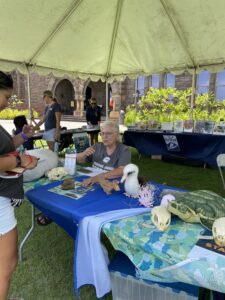 Number of People Reached Through Face-to-Face Outreach and Education in July 2023 - 2189
Number of People Reached Through Face-to-Face Outreach and Education in July 2023 - 2189
With school not in session, summer is when our Education team focuses on mostly preparing for the next year and doing public outreach. As always, our team is at Waikīkī Aquarium every other week doing outreach about monk seals, sea turtles, seabirds, and their threats. This month we also participated in the Bishop Museumʻs Seas the Day event for the second year! Weʻre always so happy to go out into our local community and talk with locals and tourists about how to be safe with protected species!
Additional News & Updates
August will mark the beginning of our Fall internship cohort! Somehow the summer interns are already wrapping up their time with us. We are so grateful to all our interns; we couldn't do what we do without them. In the next few months, we will start recruiting for the Spring semester, so if you or someone you know is interested in working in marine animal rescue or response, consider applying at h-mar.org/application!
Mahalo for your support!
______________________________________________________________________________
WHAT DO THESE NUMBERS MEAN?
Number of Calls - What does this mean? These are calls our hotline operators answer about any species in any situation. Whether it is a monk seal on the beach, a sea turtle of concern in the water, or a seabird that needs help. HMAR answers the calls that are made to the NOAA’s marine wildlife number for Oʻahu and Molokai and we take calls from the public, from the police, fire department, Ocean Safety as well as State of Hawaii agencies. Any call that comes into our hotline is reported here. Some calls result in a field response but many are valuable for animal sightings information or other data that can assist in research. Since our start in 2016, we’ve handled over 62,000 hotline contacts.
Number of Field Support Actions - What does this mean? This is when HMAR sends volunteer or staff resources into the field to perform a variety of actions in support of marine protected animals including Hawaiian monk seals, sea turtles, sea birds, dolphins, and whales. Since our start in 2016, we have had volunteers or staff in the field over 26,700 times.
Number of Rescues, Interventions, Stranding Responses and Escalated Field Actions - What does this mean? This number includes any field response that goes above and beyond a typical resting monk seal response. This includes responding to a seal of concern, an entangled, hooked, or injured sea turtle, a seabird in need of medical support, and other situations. Since 2016, we have performed nearly 2,240 of these operations.
Marine Debris Work - Each week our marine debris team removes underwater entanglement hazards (net, line, hooks) from high fishing pressure areas to reduce animal entanglements, hookings, injuries and death of protected marine animals. Since we started our underwater removal activities, our Marine Debris Program (MDP) has removed more than 5,000 animal hazards, cleaned over 275 acres of underwater habitat, and we have collected many MILES of monofilament fishing line. Taking all of this debris out of underwater habitat helps save Hawaiian monk seals, sea turtles, and seabirds.
Number of People Reached through Face to Face Outreach - What does this mean? HMAR’s different program activities put our volunteers and staff in direct contact with Hawaii’s residents and visitors. Educating people about Hawaii’s marine protected species and our ocean ecosystem is one of our highest priorities and has an important impact on reducing threats. This number includes outreach done on the beaches as well as the work our Education and Engagement team does going to classes and community outreach events. Since our start we’ve reached 313,000 people.
Thank you for your continued support!
June 2023 Update
MONTHLY HMAR UPDATE: June 2023
June was a big month for us, with many exciting as well as some devastating rescues and responses. Read on to learn all about it.
Number of Contacts Made to HMAR Hotlines in June 2023 – 1,151
There were a total of 1,151 contacts made to HMAR hotlines in June. That was broken out as 905 contacts related to Hawaiian monk seals, 159 contacts related to sea turtles, 15 contacts related to seabirds, and 72 contacts for other reasons. Remember, most of our field activity is driven by information we receive from public callers. Please report all sightings of Hawaiian monk seals. And also report any sea turtle, seabird, dolphin or whale of concern. All calls can be made to the statewide marine wildlife hotline at (888) 256-9840.
Number of Field Support Actions Conducted in June 2023 – 328
HMAR field personnel were sent into the field a total of 328 times in June. This was broken out as 170 actions in the north section of Oʻahu, 35 actions in the east section, 81 actions in the southeast section, and 42 actions in the west section of Oʻahu.
So far this year, we’ve had 7 Hawaiian monk seal pups born on Oʻahu. All 7 of them have now been weaned by their mothers! We are still expecting a few more pups to be born on Oʻahu this year - so don’t fret; pup season isn’t necessarily over yet! Our last two seals to wean were PO6 and PO7, whose permanent IDs are now respectively RS08 and RS20! We will hopefully have names to announce for these two shortly.
 In other news, a few days before the end of the month we got a call about a seal on a secluded beach, and our volunteer arrived on site to discover that it was none other than RP96, Lōliʻi! We were thrilled to see him after almost two years (see picture left). His reappearance was a great reminder that although we may not see our seals every day, that doesn’t mean that something bad has happened to them! This is particularly true for Hawaiian monk seals that live, or were released, in more remote locations. Remember, Hawaiian monk seals can travel hundreds and even a thousand miles or more within the Hawaiian Islands if they choose!
In other news, a few days before the end of the month we got a call about a seal on a secluded beach, and our volunteer arrived on site to discover that it was none other than RP96, Lōliʻi! We were thrilled to see him after almost two years (see picture left). His reappearance was a great reminder that although we may not see our seals every day, that doesn’t mean that something bad has happened to them! This is particularly true for Hawaiian monk seals that live, or were released, in more remote locations. Remember, Hawaiian monk seals can travel hundreds and even a thousand miles or more within the Hawaiian Islands if they choose!
Number of Rescues, Interventions, Stranding Responses and Escalated Field Actions in June 2023 – 23
This was broken out as 1 operation for Hawaiian monk seals, 18 operations for sea turtles, and 4 operations for seabirds. We had a number of big rescues this month. Starting with our June turtles!
We received a call about a turtle on Aliʻi Beach Park in Haleʻiwa that had a line entanglement as well as a crack in its carapace (see picture right). We arrived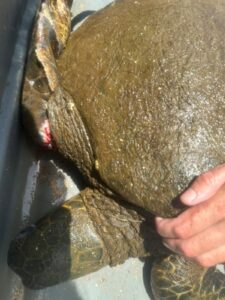 on site and decided that the turtle needed speedy transport for further care. The turtle was brought to partners on Maui and we wish this turtle a speedy and easy recovery!
on site and decided that the turtle needed speedy transport for further care. The turtle was brought to partners on Maui and we wish this turtle a speedy and easy recovery!
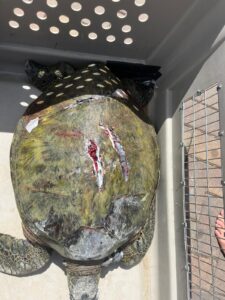
Towards the end of the month we got a call about a turtle in the Hawaiʻi Kai boat harbor that had been struck by a boat and had multiple injuries to its carapace (see picture left). We immediately responded. HMAR vessel resources were not nearby so with the help of a local boater, we were able to get out to the turtle and brought it aboard. We transported the turtle to NOAA’s facility and we’ll update you all if we get more information on it!
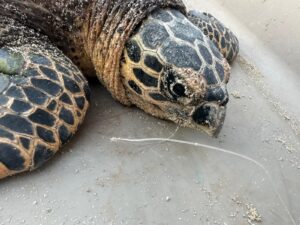 One of our favorite rescues this month was for a hawksbill turtle at Barbers Point. We don’t see hawksbills (an endangered species) very frequently on Oʻahu as they don’t nest here and are more frequently seen on Maui and the Big Island. When we received a call from a fisher stating that they had accidentally hooked a turtle and had brought it to shore, this is exactly what they should have done (see picture left)! If a fisher hooks a turtle they can call our hotline and we will advise them on the best thing to do and how to help the turtle. Because this fisher called us and
One of our favorite rescues this month was for a hawksbill turtle at Barbers Point. We don’t see hawksbills (an endangered species) very frequently on Oʻahu as they don’t nest here and are more frequently seen on Maui and the Big Island. When we received a call from a fisher stating that they had accidentally hooked a turtle and had brought it to shore, this is exactly what they should have done (see picture left)! If a fisher hooks a turtle they can call our hotline and we will advise them on the best thing to do and how to help the turtle. Because this fisher called us and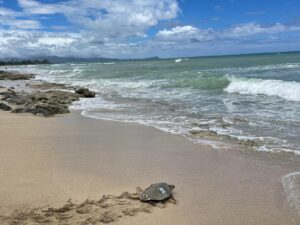 brought the turtle onto the beach we were able to quickly respond to the turtle and bring it in. NOAA was able to take some genealogical samples and give it a tag and it was able to be released the next day with no line (see picture right). Good luck out there, little guy!
brought the turtle onto the beach we were able to quickly respond to the turtle and bring it in. NOAA was able to take some genealogical samples and give it a tag and it was able to be released the next day with no line (see picture right). Good luck out there, little guy!
Unfortunately, we also had the incredibly upsetting discovery of the deceased Hawaiian monk seal RS48 “Ho’omau Lehua”. In the middle of the month, we got a call about a deceased seal on the north shore of Oʻahu. Unfortunately, it was Lehua who was born in February of this year (see picture left). Finding her was incredibly sad 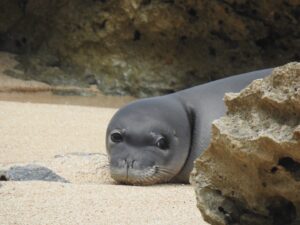 for our team since she had been seen only a few days prior, had looked fine, and had been monitored since she was born. At this time, NOAA is still in the process of completing a necropsy, however they have found that there was no sign of blunt force trauma. We are still waiting for more results which may take some time. Once we know more information, we will share it with you all on our social media.
for our team since she had been seen only a few days prior, had looked fine, and had been monitored since she was born. At this time, NOAA is still in the process of completing a necropsy, however they have found that there was no sign of blunt force trauma. We are still waiting for more results which may take some time. Once we know more information, we will share it with you all on our social media.
Marine Debris - Awesome Work
Last month we completed 3 marine debris removal dives. During those dives we collected 1,322 feet of monofilament line and 317 animal hazards! In addition, while

our "Rescue One" response boat was offshore near Ko Olina marina on a survey we found two abandoned drone fishing rigs in the area. We retrieved them and collected an additional 1,400 feet of monofilament line and 283 animal hazards. That’s an average of over 700 feet of monofilament line on each drone fishing jug dangling free in the water with hooks attached and these could have posed a significant hazard to monk seals and sea turtles!
Number of People Reached Through Face-to-Face Outreach and Education in June 2023 - 2,221
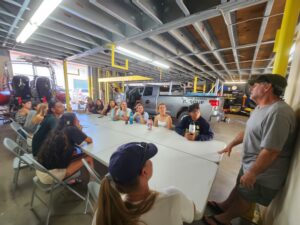 Last month we welcomed the UH Marine Mammal Research Program’s summer intensive program students to our facility to discuss what we do, who we are, and to give them a tour of our facility (see picture left). We had a blast meeting these passionate students from around the state and telling them all about our view of the marine science world. SMMILE (Summer Marine Mammal Intensive Learning Experience) is an amazing program we have worked with for two years. They do fantastic work to educate and inspire future marine scientists! If you or someone you know is interested in working with marine mammals and you live in Hawaiʻi, definitely check out SMMILE next summer! Educational activity such as this and other scheduled outreach events like our regular efforts at Waikiki Aquarium and other venues allowed us to reach 290 people last month.
Last month we welcomed the UH Marine Mammal Research Program’s summer intensive program students to our facility to discuss what we do, who we are, and to give them a tour of our facility (see picture left). We had a blast meeting these passionate students from around the state and telling them all about our view of the marine science world. SMMILE (Summer Marine Mammal Intensive Learning Experience) is an amazing program we have worked with for two years. They do fantastic work to educate and inspire future marine scientists! If you or someone you know is interested in working with marine mammals and you live in Hawaiʻi, definitely check out SMMILE next summer! Educational activity such as this and other scheduled outreach events like our regular efforts at Waikiki Aquarium and other venues allowed us to reach 290 people last month.
In addition to the outreach and educational activity we conducted in formal and scheduled settings, our team of field responders reached an additional 1,931 people with face-to-face outreach last month to improve the understanding of and support for our marine protected animals.
Additional News & Updates
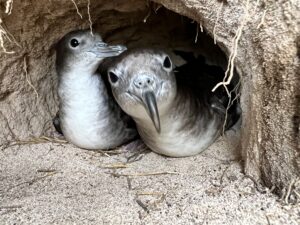 It’s officially the start of our wedgetail shearwater (WTSH) seabird season! These birds leave our island from December to April or May to forage in the equatorial and southern Pacific Ocean. They return to the island each summer and fall to nest and rear their young. HMAR manages two colonies of WTSH on Oʻahu and each year surveys at both colonies are conducted twice to collect population data - once in June or July and once in October. We completed the initial survey of our Kailua colony last month! This colony is much smaller than our other colony and very densely packed within naupaka bushes. Because of this, we only survey the colony's perimeter so as not to crush any burrows. We will survey our Kahuku colony in the next few weeks, so stay tuned for our results!
It’s officially the start of our wedgetail shearwater (WTSH) seabird season! These birds leave our island from December to April or May to forage in the equatorial and southern Pacific Ocean. They return to the island each summer and fall to nest and rear their young. HMAR manages two colonies of WTSH on Oʻahu and each year surveys at both colonies are conducted twice to collect population data - once in June or July and once in October. We completed the initial survey of our Kailua colony last month! This colony is much smaller than our other colony and very densely packed within naupaka bushes. Because of this, we only survey the colony's perimeter so as not to crush any burrows. We will survey our Kahuku colony in the next few weeks, so stay tuned for our results!
In other news from June, local Hawaiʻi-based professional photographer Erik Kabik graciously donated several of his beautiful images of Hawaiian monk seals to really spiff up some of the walls in our Kailua facility. See our social posts for images and thanks go out to Erik for his wonderful donation!
Mahalo for your support!
______________________________________________________________________________
WHAT DO THESE NUMBERS MEAN?
Number of Calls - What does this mean? These are calls our hotline operators answer about any species in any situation. Whether it is a monk seal on the beach, a sea turtle of concern in the water, or a seabird that needs help. HMAR answers the calls that are made to the NOAA’s marine wildlife number for Oʻahu and Molokai and we take calls from the public, from the police, fire department, Ocean Safety as well as State of Hawaii agencies. Any call that comes into our hotline is reported here. Some calls result in a field response but many are valuable for animal sightings information or other data that can assist in research. Since our start in 2016, we’ve handled over 61,000 hotline contacts.
Number of Field Support Actions - What does this mean? This is when HMAR sends volunteer or staff resources into the field to perform a variety of actions in support of marine protected animals including Hawaiian monk seals, sea turtles, sea birds, dolphins, and whales. Since our start in 2016, we have had volunteers or staff in the field over 26,500 times.
Number of Rescues, Interventions, Stranding Responses and Escalated Field Actions - What does this mean? This number includes any field response that goes above and beyond a typical resting monk seal response. This includes responding to a seal of concern, an entangled, hooked, or injured sea turtle, a seabird in need of medical support, and other situations. Since 2016, we have performed nearly 2,225 of these operations.
Marine Debris Work - Each week our marine debris team removes underwater entanglement hazards (net, line, hooks) from high fishing pressure areas to reduce animal entanglements, hookings, injuries and death of protected marine animals. Since we started our underwater removal activities, our Marine Debris Program (MDP) has removed more than 4,700 animal hazards, cleaned over 275 acres of underwater habitat, and we have collected many MILES of monofilament fishing line. Taking all of this debris out of underwater habitat helps save Hawaiian monk seals, sea turtles, and seabirds.
Number of People Reached through Face to Face Outreach - What does this mean? HMAR’s different program activities put our volunteers and staff in direct contact with Hawaii’s residents and visitors. Educating people about Hawaii’s marine protected species and our ocean ecosystem is one of our highest priorities and has an important impact on reducing threats. This number includes outreach done on the beaches as well as the work our Education and Engagement team does going to classes and community outreach events. Since our start we’ve reached 312,000 people.
Thank you for your continued support!
May 2023 Update
MONTHLY HMAR UPDATE: May 2023
HMAR UPDATE: MAY 2023
Spring has sprung and pup season is in full swing! Read on to learn more about HMAR’s May operations!
Number of Contacts Made to HMAR Hotlines in May 2023 – 1,267 (about 40 a day)
This was broken out as 978 contacts for Hawaiian monk seals, 186 contacts for sea turtles, 24 for seabirds, and 79 for other issues or questions.
Number of Field Support Actions Conducted in May 2023 – 501 (about 16 a day)
This was broken out as 179 actions conducted in the north section of Oʻahu, 9 actions conducted in the east section, 300 actions in the southeast section, 13 actions in the west section of Oʻahu, and 0 actions on Molokai..
 Last month we continued to support and monitor RK96 “Kaʻiwi” and her pup PO5 “Pualani” on Kaimana Beach. Pualani was gifted her name by Waikīkī Elementary School’s kindergarten and 4th grade classes and was announced at the Kaimana Beach Hotel. Our work on Kaimana Beach has been incredibly rewarding, and it has now come to a close. On May 27th, Kaʻiwi departed Kaimana Beach, leaving Pualani on her own for the first time to learn to fend and forage for herself. In the days after weaning, Pualani was collected for relocation and moved to a more remote location where human interaction will be reduced and she will likely fall into the company of other monk seals. We are happy to announce that Pualani is doing well in her new home and has been adjusting to all the aspects of her new environment. We will be monitoring her progress over the next few months and will be providing updates when we can!
Last month we continued to support and monitor RK96 “Kaʻiwi” and her pup PO5 “Pualani” on Kaimana Beach. Pualani was gifted her name by Waikīkī Elementary School’s kindergarten and 4th grade classes and was announced at the Kaimana Beach Hotel. Our work on Kaimana Beach has been incredibly rewarding, and it has now come to a close. On May 27th, Kaʻiwi departed Kaimana Beach, leaving Pualani on her own for the first time to learn to fend and forage for herself. In the days after weaning, Pualani was collected for relocation and moved to a more remote location where human interaction will be reduced and she will likely fall into the company of other monk seals. We are happy to announce that Pualani is doing well in her new home and has been adjusting to all the aspects of her new environment. We will be monitoring her progress over the next few months and will be providing updates when we can!
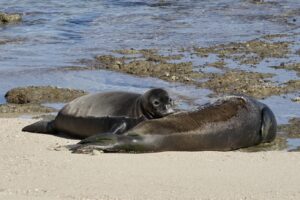
We also had two additional pups born last month to two of our sister seals on the same beach! They gave birth a few days apart and have been doing well so far. We’ll continue to monitor these seals as well as they grow - and we should have names for them both soon!
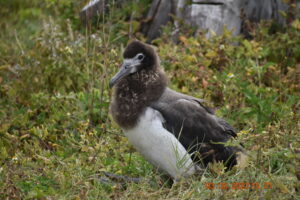 We are also coming to the close of our Laysan albatross season. Every year from November to July we monitor a colony of laysan albatross on Oʻahu's North Shore from mating to fledging and the time has almost come for the chicks to leave the nest! In the next month or so the chicks will lose their fluffy down coats and “fledge” into having adult feathers. The completion of this process means that the chicks are ready to go out to sea and forage on their own for the first time. Right now, the chicks are starting the process and getting their wings stronger by doing practice flying!
We are also coming to the close of our Laysan albatross season. Every year from November to July we monitor a colony of laysan albatross on Oʻahu's North Shore from mating to fledging and the time has almost come for the chicks to leave the nest! In the next month or so the chicks will lose their fluffy down coats and “fledge” into having adult feathers. The completion of this process means that the chicks are ready to go out to sea and forage on their own for the first time. Right now, the chicks are starting the process and getting their wings stronger by doing practice flying!
Number of Rescues, Interventions, Stranding Responses and Escalated Field Actions in May 2023 – 27
This was broken out as 4 operations for monk seals, 16 operations for sea turtles, and 7 operations for seabirds.
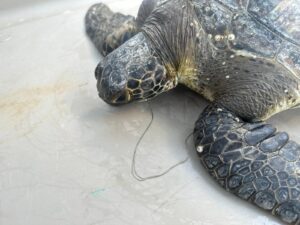 On May 13th our team received a phone call from a concerned citizen about an entangled sea turtle at Iroquois Point. Unfortunately the public caller had attempted to cut the line before we were able to arrive. Outreach was provided to the caller about the importance of allowing the experts to do a full assessment of the animal before deciding whether it is safe to disentangle the animal or not. Once we arrived on site we were able to determine that the turtle had ingested line and therefore needed to be transported for additional care.
On May 13th our team received a phone call from a concerned citizen about an entangled sea turtle at Iroquois Point. Unfortunately the public caller had attempted to cut the line before we were able to arrive. Outreach was provided to the caller about the importance of allowing the experts to do a full assessment of the animal before deciding whether it is safe to disentangle the animal or not. Once we arrived on site we were able to determine that the turtle had ingested line and therefore needed to be transported for additional care.
 A few months ago we gave you all an update on MA260, an adult female green sea turtle that we rescued in January of 2022 and was released back on Oʻahu a few months ago (If you want more information check out our 2022 Year In Review and February 2023 blog posts). She was seen again on the north shore of Oʻahu a number of times this month and continues to do well and heal. We’re excited for the opportunity to continue to monitor her progress!
A few months ago we gave you all an update on MA260, an adult female green sea turtle that we rescued in January of 2022 and was released back on Oʻahu a few months ago (If you want more information check out our 2022 Year In Review and February 2023 blog posts). She was seen again on the north shore of Oʻahu a number of times this month and continues to do well and heal. We’re excited for the opportunity to continue to monitor her progress!
Remember, if you see a marine protected animal of concern, please do not attempt to intervene. This can be dangerous for you, can result in further problems for the animal, does not allow us to conduct a proper assessment and examination of the animal, and likely constitutes a violation of federal and state laws. What is most important is that you call the statewide marine animal hotline at (888) 256-9840 as quickly as possible, provide photos, and detailed GPS or location information. Your quick and detailed contact will allow us to determine the best action to take and allows us to dispatch trained and permitted responders as needed.
Marine Debris - New Programs and Projects!
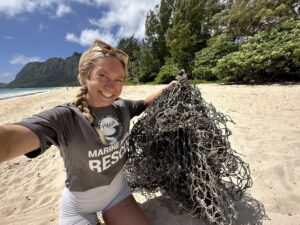 This month we completed a total of 3 dives. During those dives we collected 367 feet of monofilament and 122 animal hazards! We also retrieved a derelict net on shore in Waimānalo which was the first net recovery under our new contract with the State of Hawaiʻi Division of Aquatic Resources (DAR) and their Marine Debris Rapid Response Program. The net was recovered by Jace, one of our Marine Support Technicians, and it is currently at our facility for processing! We’re excited to continue down the path of large onshore debris recovery with our partners at DAR!
This month we completed a total of 3 dives. During those dives we collected 367 feet of monofilament and 122 animal hazards! We also retrieved a derelict net on shore in Waimānalo which was the first net recovery under our new contract with the State of Hawaiʻi Division of Aquatic Resources (DAR) and their Marine Debris Rapid Response Program. The net was recovered by Jace, one of our Marine Support Technicians, and it is currently at our facility for processing! We’re excited to continue down the path of large onshore debris recovery with our partners at DAR!
Number of People Reached Through Face to Face Outreach and Education in May 2023 - 1,327
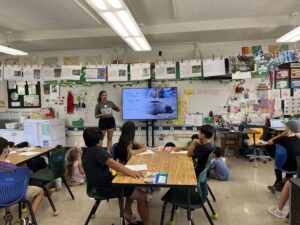 Our Education team did a number of fun and interesting presentations this month! One of our favorite educational activities is helping school kids name monk seal pups. Last month we worked with Waikīkī Elementary to name PO5 on Kaimana Beach. After a lot of work and dedication the students landed on Pualani, or heavenly flower, for PO5’s name. The students who named Pualani were in kindergarten and the 4th grade. They worked together to find the perfect name!
Our Education team did a number of fun and interesting presentations this month! One of our favorite educational activities is helping school kids name monk seal pups. Last month we worked with Waikīkī Elementary to name PO5 on Kaimana Beach. After a lot of work and dedication the students landed on Pualani, or heavenly flower, for PO5’s name. The students who named Pualani were in kindergarten and the 4th grade. They worked together to find the perfect name!
We also did a presentation with the Honolulu Rotary Club on sentinel species! Never heard of a sentinel species before? These are animals that can be used by scientists to understand changes going on in the environment that may someday impact humans. Monk seals, sea turtles and seabirds are all sentinel species in Hawaiʻi!
In addition to the people reached through educational presentations and other community events, our Field Support & Outreach team reached several thousand additional people through our field response activity.
Additional News & Updates
May was a busy onboarding month! We have new employees, interns and volunteers to introduce! We filled an additional Marine Support Technician position and would like to introduce Clara Orr! Clara is a recent University of Hawaiʻi at Mānoa graduate who studied Marine Biology. She is joining Jace and Anabel as the team members organizing our marine debris and on-water marine operations programs. Welcome aboard Clara!
We also onboarded 9 new interns and 5 new volunteers this month. Our summer internship is now in full swing and this group will be with us until mid-August. These interns will be working in our Field Support & Outreach (FSO) program as well as supporting our rescue responses as well. Our new volunteers also completed their training this month and we’re so excited to have a new group. Our next new volunteer training will be on July 1st so if youʻre interested in applying please visit h-mar.org/application for more information. We are also beginning the process of interviewing for our fall internship. You can learn more about our volunteer and internship programs at h-mar.org/jointheteam!
Mahalo for your support!
______________________________________________________________________________
WHAT DO THESE NUMBERS MEAN?
Number of Calls - What does this mean? These are calls our hotline operators answer about any species in any situation. Whether it is a monk seal on the beach, a sea turtle of concern in the water, or a seabird that needs help. HMAR answers the calls that are made to the NOAA’s marine wildlife number for Oʻahu and Molokai and we take calls from the public, from the police, fire department, Ocean Safety as well as State of Hawaii agencies. Any call that comes into our hotline is reported here. Some calls result in a field response but many are valuable for animal sightings information or other data that can assist in research. Since our start in 2016, we’ve handled over 60,000 hotline contacts.
Number of Field Support Actions - What does this mean? This is when HMAR sends volunteer or staff resources into the field to perform a variety of actions in support of marine protected animals including Hawaiian monk seals, sea turtles, sea birds, dolphins, and whales. Since our start in 2016, we have had volunteers or staff in the field over 26,000 times.
Number of Rescues, Interventions, Stranding Responses and Escalated Field Actions - What does this mean? This number includes any field response that goes above and beyond a typical resting monk seal response. This includes responding to a seal of concern, an entangled, hooked, or injured sea turtle, a seabird in need of medical support, and other situations. Since 2016, we have performed nearly 2,200 of these operations.
Marine Debris Work - Each week our marine debris team removes underwater entanglement hazards (net, line, hooks) from high fishing pressure areas to reduce animal entanglements, hookings, injuries and death of protected marine animals. Since we started our underwater removal activities, our Marine Debris Program (MDP) has removed more than 4,400 animal hazards, cleaned over 270 acres of underwater habitat, and we have collected many MILES of monofilament fishing line. Taking all of this debris out of underwater habitat helps save Hawaiian monk seals, sea turtles, and seabirds.
Number of People Reached through Face to Face Outreach - What does this mean? HMAR’s different program activities put our volunteers and staff in direct contact with Hawaii’s residents and visitors. Educating people about Hawaii’s marine protected species and our ocean ecosystem is one of our highest priorities and has an important impact on reducing threats. This number includes outreach done on the beaches as well as the work our Education and Engagement team does going to classes and community outreach events. Since our start we’ve reached 310,000 people.
Thank you for your continued support!
April 2023 Update
MONTHLY HMAR UPDATE: April 2023
HMAR UPDATE: APRIL 2023
April was Earth Month and we had a pup born on Kaimana Beach so it has been busy busy busy! Read on for more information!
Number of Contacts Made to HMAR Hotlines in April 2023 – 971 (about 33 a day)
This was broken down as 738 contacts for Hawaiian monk seals, 156 for sea turtles, 17 for seabirds, and about 60 other contacts unrelated to the protected species we work with.
Number of Field Support Actions Conducted in April 2023 – 290 (about 10 a day)
This was broken down as 83 actions on the east side of the island, 65 on the west side, 5 on the north side, and 137 in the southeast area of the island.
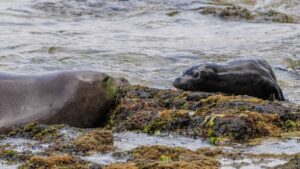 We had two Hawaiian monk seal pups born in April! On the 2nd of the month on an offshore island, PO4 was born. Our fourth pup being born in April was definitely earlier than we expected but we’re so excited to be adding new pups to our Oʻahu family! On April 14th, PO5 was born! If you haven’t seen us on our social media yet - RK96 “Kaʻiwi” gave birth to her fifth pup (and the 5th pup on Oʻahu of 2023) on Kaimana Beach in Waikīkī. Since then, we and our partners (NOAA, Ocean Safety, DLNR Division of Conservation and Resources Enforcement (DOCARE), DLNR Division of Aquatic Resources (DAR), DLNR Division of Boating and Ocean Recreation (DOBOR), and Honolulu Police Department have been working together to manage a larger perimeter than usual to ensure human and seal safety. We have been on the beach 14 hours each day since birth and will continue to be for the foreseeable future! PO5 will also be gifted a name by Waikīkī Elementary School in the coming weeks and we’ll announce that on our social media.
We had two Hawaiian monk seal pups born in April! On the 2nd of the month on an offshore island, PO4 was born. Our fourth pup being born in April was definitely earlier than we expected but we’re so excited to be adding new pups to our Oʻahu family! On April 14th, PO5 was born! If you haven’t seen us on our social media yet - RK96 “Kaʻiwi” gave birth to her fifth pup (and the 5th pup on Oʻahu of 2023) on Kaimana Beach in Waikīkī. Since then, we and our partners (NOAA, Ocean Safety, DLNR Division of Conservation and Resources Enforcement (DOCARE), DLNR Division of Aquatic Resources (DAR), DLNR Division of Boating and Ocean Recreation (DOBOR), and Honolulu Police Department have been working together to manage a larger perimeter than usual to ensure human and seal safety. We have been on the beach 14 hours each day since birth and will continue to be for the foreseeable future! PO5 will also be gifted a name by Waikīkī Elementary School in the coming weeks and we’ll announce that on our social media.
Number of Rescues, Interventions, Stranding Responses and Escalated Field Actions in April 2023 – 19
This was broken down as 7 operations on the east side, 6 on the west side, 2 on the north side, and 4 in the southeast side of the island. These escalated activities included 10 operations for sea turtles, 7 operations for seabirds, and 2 operations for Hawaiian monk seals.
Here are a couple of highlights from these operations.
At the end of April we received a call while some of our team was on the North Shore. An adult turtle was on the beach at Laniakea Beach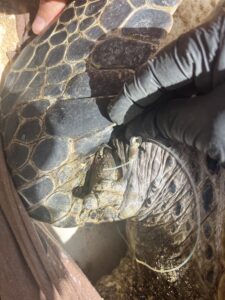
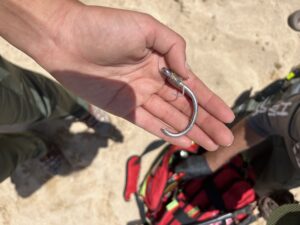 with a large hook in its right fore flipper. Our team was able to be there in a matter of minutes due to their close proximity. The turtle was basking on the beach and our team was able to capture the animal, assess its condition, and examine the hook. The ulua hook had about 12 inches of line which was thankfully not entangled around the animal. The hook had gone completely through the flipper and the barb was on the other side. The sea turtle was otherwise in good body condition and appeared healthy. This meant that by using a pair of bolt cutters we were able to cut the hook point and barb end and remove the rest of the hook with the line attached. The turtle was very strong and active (it actually broke our bin that it was contained in) and was released immediately after!
with a large hook in its right fore flipper. Our team was able to be there in a matter of minutes due to their close proximity. The turtle was basking on the beach and our team was able to capture the animal, assess its condition, and examine the hook. The ulua hook had about 12 inches of line which was thankfully not entangled around the animal. The hook had gone completely through the flipper and the barb was on the other side. The sea turtle was otherwise in good body condition and appeared healthy. This meant that by using a pair of bolt cutters we were able to cut the hook point and barb end and remove the rest of the hook with the line attached. The turtle was very strong and active (it actually broke our bin that it was contained in) and was released immediately after!
We also had an injured brown booby rescue at Baby Makapuʻu Beach. The bird was sitting on the rocks creating a tide pool with a drooping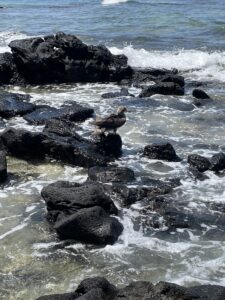 wing. The tide was quickly coming in and the bird was continuing to lose its balance and almost fall into the water. Our team was able to respond and carefully retrieve the bird and assess its condition. It had very high energy levels and tried to escape capture, but without working wings it didn't have much success. We were able to gently capture this beautiful seabird and transport it to our partners at Feather and Fur Animal Hospital in Kailua for veterinary support.
wing. The tide was quickly coming in and the bird was continuing to lose its balance and almost fall into the water. Our team was able to respond and carefully retrieve the bird and assess its condition. It had very high energy levels and tried to escape capture, but without working wings it didn't have much success. We were able to gently capture this beautiful seabird and transport it to our partners at Feather and Fur Animal Hospital in Kailua for veterinary support.
Remember, if you see a marine protected animal of concern, please do not attempt to intervene. This can be dangerous for you, can result in further problems for the animal, does not allow us to conduct a proper assessment and examination of the animal, and likely constitutes a violation of federal and state laws. What is most important is that you call the statewide marine animal hotline at (888) 256-9840 as quickly as possible, provide photos, and detailed GPS or location information. Your quick and detailed contact will allow us to determine the best action to take and allows us to dispatch trained and permitted responders as needed.
Marine Debris - New Programs and Projects!
Last month we dove 4 times and collected 2,275 feet of monofilament and 110 animal hazards that pose an injury or death threat to Hawaiian monk seals, sea turtles, and seabirds. During these dives we cleared about 6.5 acres of underwater habitat!
Last month we were thrilled that we received a contract from the State of Hawaiʻi DLNR Division of Aquatic Resources (DAR) to be their
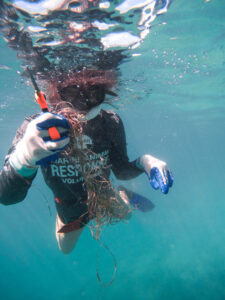
designated partner for their Marine Debris Rapid Response program on Oʻahu. Every month we dive all around Oʻahu's nearshore waters to collect underwater entanglement hazards. This contract will expand our Marine Debris Program to also include debris on land including large derelict nets on shore and at sea! We’re happy we’re able to continue to grow our partnership with the State of Hawaiʻi and to have new opportunities to support the health of Oʻahu's ocean ecosystem.
Number of People Reached Through Face to Face Outreach and Education in April 2023 - 2,801
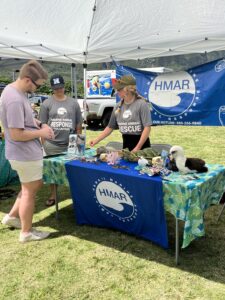 April was Earth Month! Our Education team was extremely busy with four events over the course of two weekends. During Earth week we talked with the public about the dangers of plastic pollution and derelict fishing gear for Hawaiʻi's marine protected species. Over the course of those four events we talked to almost 1,000 people! We also reached an additional 1,800 people through outreach conducted during our ongoing field response, rescue, and other support activity.
April was Earth Month! Our Education team was extremely busy with four events over the course of two weekends. During Earth week we talked with the public about the dangers of plastic pollution and derelict fishing gear for Hawaiʻi's marine protected species. Over the course of those four events we talked to almost 1,000 people! We also reached an additional 1,800 people through outreach conducted during our ongoing field response, rescue, and other support activity.
Additional News & Updates
This month we hired two new staff positions. Cameron Aroz is our new Operations Support Technician. Cam was an HMAR intern earlier this semester and in the middle of her internship we scooped her up and brought her onto our staff team. She is a graduate of University of Oregon with a degree in Multidisciplinary Science with a Marine Concentration. Jace Reinken was also hired as a Marine Support Technician. Jace was an HMAR intern in the summer of 2022 and graduated from UH Mānoa last fall. We are so excited to have both Jace and Cam joining the HMAR team, and if you see them in the field, be sure to say hello!
was an HMAR intern earlier this semester and in the middle of her internship we scooped her up and brought her onto our staff team. She is a graduate of University of Oregon with a degree in Multidisciplinary Science with a Marine Concentration. Jace Reinken was also hired as a Marine Support Technician. Jace was an HMAR intern in the summer of 2022 and graduated from UH Mānoa last fall. We are so excited to have both Jace and Cam joining the HMAR team, and if you see them in the field, be sure to say hello!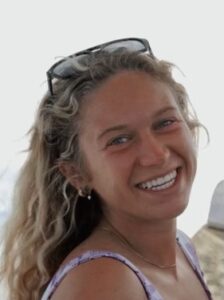
This month we also officially began our offshore islands sea turtle nest surveys for the 2023 season. Our team will be using our kayaks and our Rescue 1 vessel to access these islands to search for nesting indicators. We’ll be tracking these potential nesting sites for our partners at the U.S. Fish and Wildlife Service Pacific Islands Coastal Program..
As a reminder - if youʻre interested in volunteering with us please go to HERE. Our next new volunteer orientation is on Saturday May 20th so there is still time to apply and get a seat in upcoming training. If you can’t volunteer we still could use your help. Please go HERE to give your financial support so we can continue our important work.
Mahalo for your support!
______________________________________________________________________________
WHAT DO THESE NUMBERS MEAN?
Number of Calls - What does this mean? These are calls our hotline operators answer about any species in any situation. Whether it is a monk seal on the beach, a sea turtle of concern in the water, or a seabird that needs help. HMAR answers the calls that are made to the NOAA’s marine wildlife number for Oʻahu and Molokai and we take calls from the public, from the police, fire department, Ocean Safety as well as State of Hawaii agencies. Any call that comes into our hotline is reported here. Some calls result in a field response but many are valuable for animal sightings information or other data that can assist in research. Since our start in 2016, we’ve handled over 58,000 hotline contacts.
Number of Field Support Actions - What does this mean? This is when HMAR sends volunteer or staff resources into the field to perform a variety of actions in support of marine protected animals including Hawaiian monk seals, sea turtles, sea birds, dolphins, and whales. Since our start in 2016, we have had volunteers or staff in the field over 25,000 times.
Number of Rescues, Interventions, Stranding Responses and Escalated Field Actions - What does this mean? This number includes any field response that goes above and beyond a typical resting monk seal response. This includes responding to a seal of concern, an entangled, hooked, or injured sea turtle, a seabird in need of medical support, and other situations. Since 2016, we have performed over 2,145 of these operations.
Marine Debris Work - Each week our marine debris team removes underwater entanglement hazards (net, line, hooks) from high fishing pressure areas to reduce animal entanglements, hookings, injuries and death of protected marine animals. Since we started our underwater removal activities, our Marine Debris Program (MDP) has removed more than 4,300 animal hazards, cleaned over 270 acres of underwater habitat, and we have collected many MILES of monofilament fishing line. Taking all of this debris out of underwater habitat helps save Hawaiian monk seals, sea turtles, and seabirds.
Number of People Reached through Face to Face Outreach - What does this mean? HMAR’s different program activities put our volunteers and staff in direct contact with Hawaii’s residents and visitors. Educating people about Hawaii’s marine protected species and our ocean ecosystem is one of our highest priorities and has an important impact on reducing threats. This number includes outreach done on the beaches as well as the work our Education and Engagement team does going to classes and community outreach events. Since our start we’ve reached over 303,000 people.
Thank you for your continued support!
March 2023 Update
MONTHLY HMAR UPDATE: March 2023
March was the month of turtles! We responded to quite a few sea turtles throughout the course of the month. Read on to learn more!
Number of Contacts Made to HMAR Hotlines in March 2023 – 1,274 (about 43 a day)
In March there were a total of 1,274 contact made to our hotlines on Oʻahu. 979 of those were related to Hawaiian monk seals, 198 were related to sea turtles, 17 were related to seabirds, and 80 contacts were made concerning other topics.
Number of Field Support Actions Conducted in March 2023 – 385 (about 13 a day)
Welcome to the world PO2 and PO3! That’s right, we have two new Hawaiian monk seal pups on Oʻahu! PO2 was born at the end of February, but we didn’t want to announce the birth in our last monthly update and instead held off until more time had passed! PO2 was born February 23rd on the north shore of Oʻahu - mom Lei Ola (RH48) is also a first timer this year! So far everything has been going well! PO2 was officially given her name at the end of March by Hau'ula Elementary School. We would like to introduce you all to Ho'omau Lehua - meaning the enduring flower of the ʻŌhiʻa tree! Check out our recent social media post for more info about PO2ʻs name!
February, but we didn’t want to announce the birth in our last monthly update and instead held off until more time had passed! PO2 was born February 23rd on the north shore of Oʻahu - mom Lei Ola (RH48) is also a first timer this year! So far everything has been going well! PO2 was officially given her name at the end of March by Hau'ula Elementary School. We would like to introduce you all to Ho'omau Lehua - meaning the enduring flower of the ʻŌhiʻa tree! Check out our recent social media post for more info about PO2ʻs name!
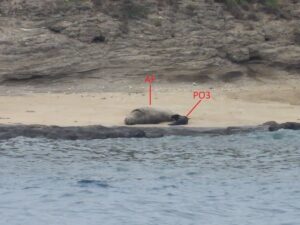
PO3 was born on March 23rd on an offshore island! So far mom and pup seem to be doing well and we are excited to see how things keep going for the pair. We should be having a number of other pups born on Oʻahu this year and we’re excited to keep the updates coming for you all.
Number of Rescues, Interventions, Stranding Responses and Escalated Field Actions in March 2023 – 27 (about one every day)
On March 15th we received a call from a concerned member of the public about a downed brown booby at Alan Davis beach. Once our team arrived on site the bird appeared to have a fishing hook embedded in its right wing. We were able to capture the bird and transport it to Feather and Fur animal hospital where it was further evaluated by veterinarians.
On the 26th of March we received a call from two paddle boarders on the Haleiwa River. They had found a turtle with rope wrapped around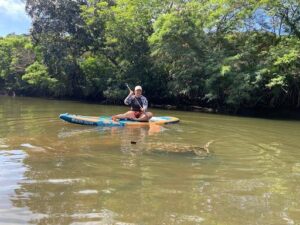 its front flipper and extending to a nearby tree. Our team got prepped with kayaks to transport the turtle down the river. We were lucky that Tsue’s Farm let us launch our kayaks from their dock to retrieve the turtle. Unfortunately by the time we arrived someone had cut the turtle loose from the tree which made our job a little more difficult. The turtle was slowly swimming in the river, actively diving and moving around, but we could clearly see the rope entanglement and floater that the animal was carrying. Eventually we were able to use a net to retrieve the turtle and transport her down the river to our truck. Once we had her on dry land we saw that not only did he have the rope entanglement but she also had fishing line tightly wrapped around both front flippers - so she needed to see a veterinarian. So we made the journey to NOAA for her evaluation. We recently found out that she has been transported to our partner on Maui for further care! We hope to have more updates for you all in the coming weeks!
its front flipper and extending to a nearby tree. Our team got prepped with kayaks to transport the turtle down the river. We were lucky that Tsue’s Farm let us launch our kayaks from their dock to retrieve the turtle. Unfortunately by the time we arrived someone had cut the turtle loose from the tree which made our job a little more difficult. The turtle was slowly swimming in the river, actively diving and moving around, but we could clearly see the rope entanglement and floater that the animal was carrying. Eventually we were able to use a net to retrieve the turtle and transport her down the river to our truck. Once we had her on dry land we saw that not only did he have the rope entanglement but she also had fishing line tightly wrapped around both front flippers - so she needed to see a veterinarian. So we made the journey to NOAA for her evaluation. We recently found out that she has been transported to our partner on Maui for further care! We hope to have more updates for you all in the coming weeks!
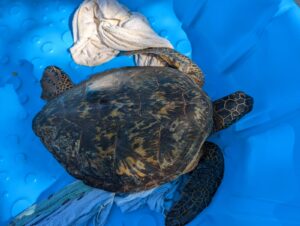 We also had two rescues of sea turtles at the HECO plant this month! Our first response was to a turtle with line wrapped tightly around its left front flipper. The flipper appeared swollen but we didn’t see any sign of dead tissue, however the tightness of the line led us to decide to bring the turtle to a veterinarian for further examination. This turtle is now receiving further care on Maui as well. Our second HECO turtle response happened a few days later. The turtle was inside their intake pipe, thankfully the team at the plant was able to get the turtle out of the pipe and we could assess the animal. Thankfully the turtle was active, and in good body condition. We decided to release the turtle a ways down the road so it wouldn’t return to the intake pipe. The second we released the turtle onto the sand it made a beeline for the water and swam off!
We also had two rescues of sea turtles at the HECO plant this month! Our first response was to a turtle with line wrapped tightly around its left front flipper. The flipper appeared swollen but we didn’t see any sign of dead tissue, however the tightness of the line led us to decide to bring the turtle to a veterinarian for further examination. This turtle is now receiving further care on Maui as well. Our second HECO turtle response happened a few days later. The turtle was inside their intake pipe, thankfully the team at the plant was able to get the turtle out of the pipe and we could assess the animal. Thankfully the turtle was active, and in good body condition. We decided to release the turtle a ways down the road so it wouldn’t return to the intake pipe. The second we released the turtle onto the sand it made a beeline for the water and swam off!
Marine Debris - Great March Results
This month our MDP team completed three dives. Over these three dives we cleaned up a total of 27 pounds of debris over 5.2 acres. This
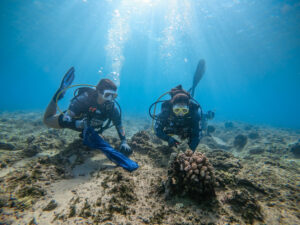
consisted of 2,077 feet of monofilament line, and 59 animal hazards. In addition to our cleanups we also announced our upcoming BEAT Debris contest! From April 1 to July 31st if you submit your debris report to h-mar.org/debrisreport you can be entered to win a dive shop gift card. Remember you can fill out a report no matter which island you live on! For more info check our social channels and h-mar.org/beatdebris.
Number of People Reached Through Face to Face Outreach and Education in March 2023 - 1,603 people
March was a continuation of all our typical education presentations - but we are starting to prepare for the Super Bowl of Environmentalism: Earth Day. April is going to be a whirlwind for our team. With 4 HUGE events over the course of a week we’ll be busy busy busy. If you want to come see us while weʻre out an about, keep an eye on our Instagram stories!
Additional News & Updates
We had our second volunteer class of 2023 in March. We had about 15 people go through training this month and they have all since passed their exams! If you are interested in joining our volunteer team you can submit an application at h-mar.org/application. You can participate in our monk seal, marine debris, education or hotline programs! We will be having our next orientation on May 20th, 2023!
As always, we can’t do the work we do without all of you! We rely heavily on donations to pay for gas, supplies, insurance, rent, truck maintenance, and all the other things we need to do our work. Marine animal response, rescue, and education is very rewarding but not inexpensive. If you want to support us, please donate or consider volunteering HERE, and every dollar helps. Mahalo for your support. Please check back with us for next month’s update!
Mahalo for your support!
______________________________________________________________________________
WHAT DO THESE NUMBERS MEAN?
Number of Calls - What does this mean? These are calls our hotline operators answer about any species in any situation. Whether it is a monk seal on the beach, a sea turtle of concern in the water, or a seabird that needs help. HMAR answers the calls that are made to the NOAA’s marine wildlife number for Oʻahu and Molokai and we take calls from the public, from the police, fire department, Ocean Safety as well as State of Hawaii agencies. Any call that comes into our hotline is reported here. Some calls result in a field response but many are valuable for animal sightings information or other data that can assist in research. Since our start in 2016, we’ve handled over 58,000 hotline contacts.
Number of Field Support Actions - What does this mean? This is when HMAR sends volunteer or staff resources into the field to perform a variety of actions in support of marine protected animals including Hawaiian monk seals, sea turtles, sea birds, dolphins, and whales. Since our start in 2016, we have had volunteers or staff in the field over 25,000 times.
Number of Rescues, Interventions, Stranding Responses and Escalated Field Actions - What does this mean? This number includes any field response that goes above and beyond a typical resting monk seal response. This includes responding to a seal of concern, an entangled, hooked, or injured sea turtle, a seabird in need of medical support, and other situations. Since 2016, we have performed over 2,145 of these operations.
Marine Debris Work - Each week our marine debris team removes underwater entanglement hazards (net, line, hooks) from high fishing pressure areas to reduce animal entanglements, hookings, injuries and death of protected marine animals. Since we started our underwater removal activities, our Marine Debris Program (MDP) has removed more than 4,300 animal hazards, cleaned over 270 acres of underwater habitat, and we have collected many MILES of monofilament fishing line. Taking all of this debris out of underwater habitat helps save Hawaiian monk seals, sea turtles, and seabirds.
Number of People Reached through Face to Face Outreach - What does this mean? HMAR’s different program activities put our volunteers and staff in direct contact with Hawaii’s residents and visitors. Educating people about Hawaii’s marine protected species and our ocean ecosystem is one of our highest priorities and has an important impact on reducing threats. This number includes outreach done on the beaches as well as the work our Education and Engagement team does going to classes and community outreach events. Since our start we’ve reached over 303,000 people.
